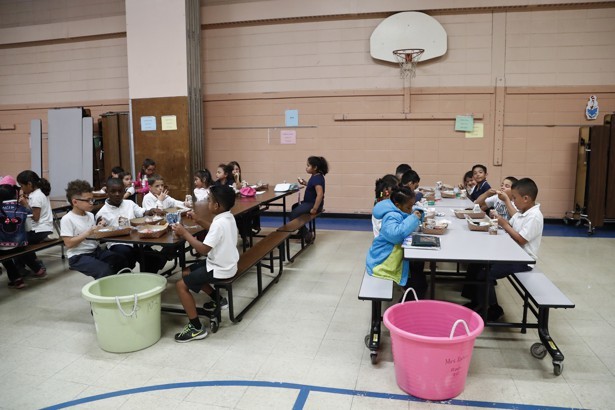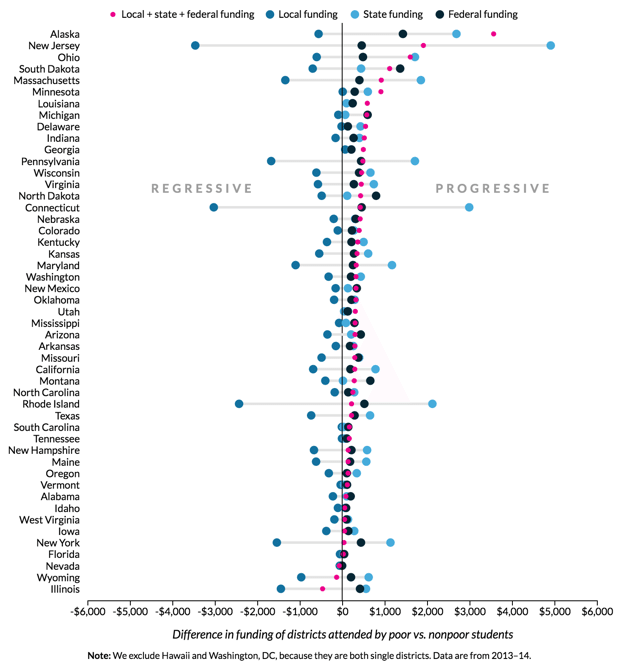Thirty-five states have policies engineered toward sending extra dollars to needy districts. But not all are successful.

Students at Little Fort Elementary School in Waukegan, Illinois. Illinois is one of three states where school funding is regressive overall. (Kamil Krzaczynski / AP)
Districts serving many low-income children in New Jersey receive nearly $5,000 more per pupil from the state government than districts with a fewer poor students. If that same district was located in Montana, it would only receive an extra $18 per student from the state. Despite the fact that the majority of states have education funding formulas meant to target low-income students, the effectiveness of this targeting varies widely around the country.
In states where districts are more economically segregated, policymakers have an easier time targeting funding to the neediest students. Because poor children benefit more than their wealthier counterparts from increased per pupil funding, a correctly tuned targeting formula could be an important step toward closing the achievement gap. According to a new report released by the Urban Institute, a social- and economic-policy nonprofit in Washington, D.C., the degree to which funding is targeted is inconsistent among states. In three states—Nevada, Wyoming, and Illinois—non-poor students attend better funded school districts despite state and federal government efforts to level the playing field.
School districts receive local, state, and federal funding, and available local dollars typically reflect the socioeconomic makeup of a community. In areas where students come from higher income brackets, the researchers found, families typically pay more in property taxes, which help fund schools. As a result, local funding is regressive—meaning more of it flows to schools with fewer low-income students—in all but a few states. In some cases, the disparity is extreme: Districts in New Jersey with fewer poor students receive about $3,460 more in per pupil local funding. On the other side, poorer districts receive $242 more per student in local money in Louisiana.
 To compensate for these disparities, 35 states have funding formulas meant to target districts with larger populations of poor students with extra dollars. This practice is known as progressive funding because the government infuses resources at a disproportionate rate to the districts that need them most. In many places, including New Jersey, Alaska, and Massachusetts, state governments are able to help balance out regressive local funding with state dollars, making overall education funding in the state progressive.
To compensate for these disparities, 35 states have funding formulas meant to target districts with larger populations of poor students with extra dollars. This practice is known as progressive funding because the government infuses resources at a disproportionate rate to the districts that need them most. In many places, including New Jersey, Alaska, and Massachusetts, state governments are able to help balance out regressive local funding with state dollars, making overall education funding in the state progressive.
“People tend to think that schools are underfunded and in some places, they seem to be doing okay. Of course, it depends on what your standard is,” Matthew Chingos, a senior fellow at the Urban Institute, said. “I think the narrative out there is that in some places, poor kids are really getting a raw deal.”
But states that are more successful at counteracting disparities at the local level tend to have an unsavory distinction: increased economic segregation at the district level. In states where the districts tend to be smaller and therefore more socioeconomically homogenous, policymakers have an easier time creating funding formulas that give the neediest students a leg up, researchers found. Chingos said this commonality is more reflective of how district boundaries are drawn than of a state’s total level of economic segregation. But simply put, if there is a higher percentage of poor students in one district, it is more obvious that pumping additional resources into that district will have an outsized benefit in closing the achievement gap. In states like Florida where there is neighborhood segregation but where school districts tend to be larger, the economic diversity of the student population in each district is higher, so local funding is less regressive to begin with.
That said, despite such a high number of states working to fine-tune their education funding to help poorer districts, researchers found that districts with more poor students are getting more money in just 28 states. In 16 of those 28 states, funding is progressive by less than $150 per student.
“We find that there’s this disconnect between these 35 states that have these provisions in their formulas and then a whole bunch of states that don’t actually have funding … that’s all that progressive,” Chingos said.
Ultimately, Chingos said, the report could help policymakers compare their efforts to their counterparts around the country. The solution is not simply to make school districts smaller and more homogenous, he said. The economics of smaller systems can be more precarious and researchers have found that students who attend disadvantaged, economically segregated schools suffer from educational and economic handicaps later in life.
Taking into account federal dollars, the report found all but three states are at least weakly progressive with their education funding. One of the largest sources of this government money is Title I, the funding for which was held constant in President Trump’s recently released budget proposal.
Written by Hayley Glatter and published by The Atlantic ~ June 1, 2017.
 FAIR USE NOTICE: This site contains copyrighted material the use of which has not always been specifically authorized by the copyright owner. We are making such material available in our efforts to advance understanding of environmental, political, human rights, economic, democracy, scientific, and social justice issues, etc. We believe this constitutes a ‘fair use’ of any such copyrighted material as provided for in section 107 of the US Copyright Law. In accordance with Title 17 U. S. C. Section 107, the material on this site is distributed without profit to those who have expressed a prior interest in receiving the included information for research and educational purposes. For more information go to: http://www.law.cornell.edu/uscode/17/107.shtml
FAIR USE NOTICE: This site contains copyrighted material the use of which has not always been specifically authorized by the copyright owner. We are making such material available in our efforts to advance understanding of environmental, political, human rights, economic, democracy, scientific, and social justice issues, etc. We believe this constitutes a ‘fair use’ of any such copyrighted material as provided for in section 107 of the US Copyright Law. In accordance with Title 17 U. S. C. Section 107, the material on this site is distributed without profit to those who have expressed a prior interest in receiving the included information for research and educational purposes. For more information go to: http://www.law.cornell.edu/uscode/17/107.shtml
